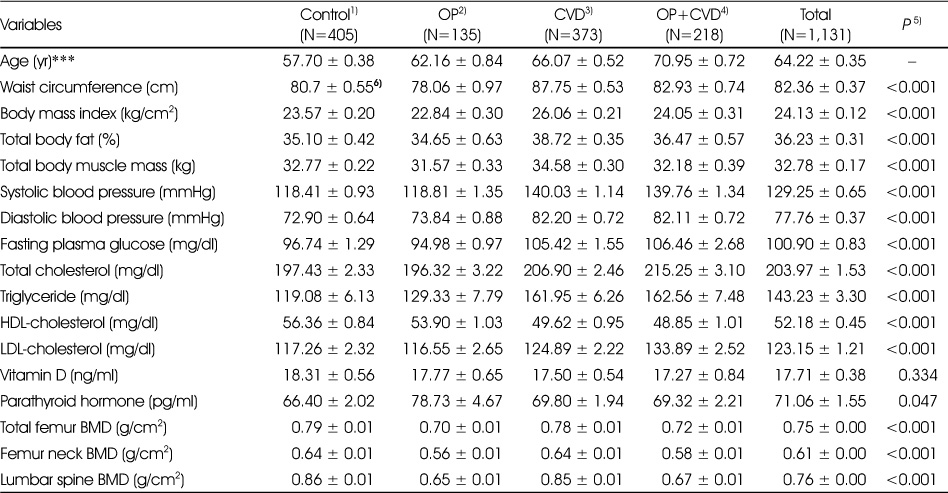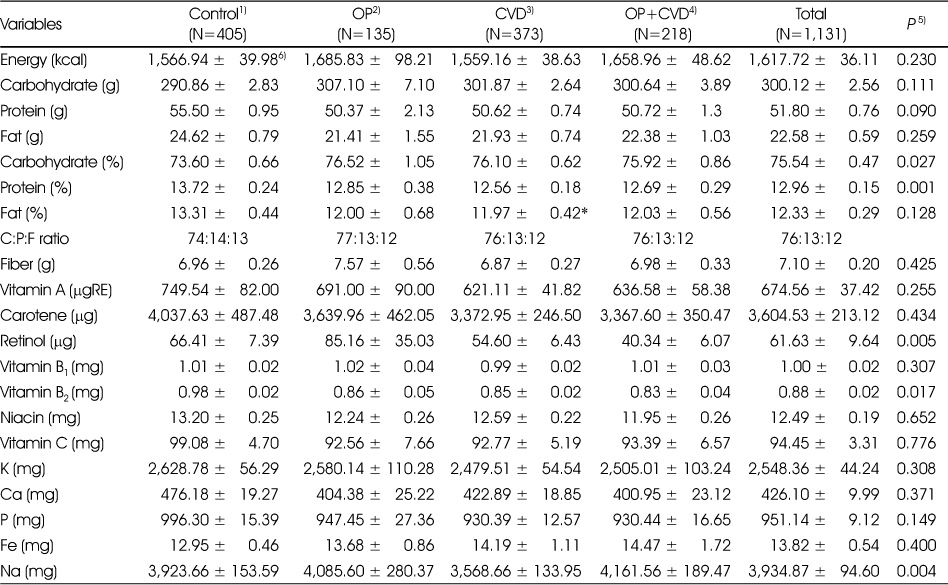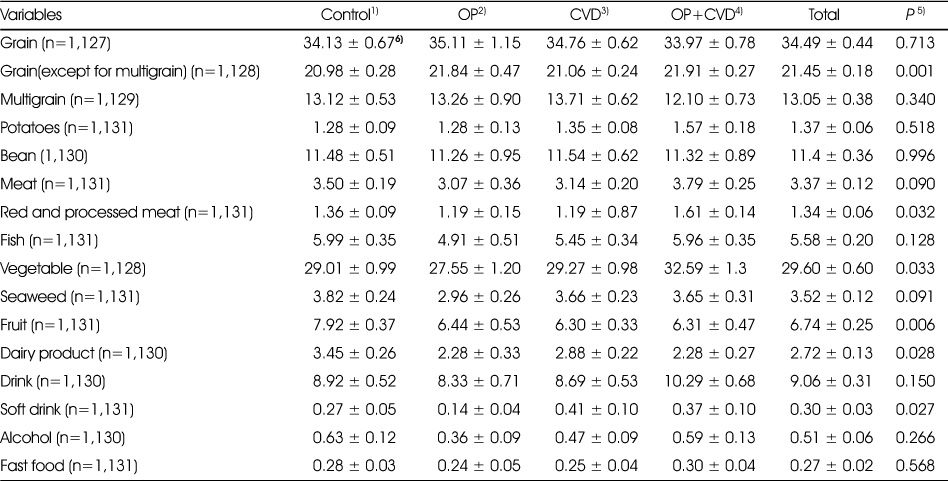References
1. Santoro N, Epperson CN, Mathews SB. Menopausal symptoms and their management. Endocrinol Metab Clin North Am 2015;44(3):497–515.
2. Choi SH, Hwang DK, Song HR, Noh HJ, Kang JY, Choi DH. The predictors for lumbar spinal bone mineral density in premenopausal and postmenopausal women in Korea. J Korean Soc Menopause 2009;15(2):101–109.
3. Kim DS, Shon HC, Kim YM, Choi ES, Park KJ, Im SH. Postoperative mortality and the associated factors for senile hip fracture patients. J Korean Orthop Assoc 2008;43(4):488–494.
4. Sang JH, Hwang IC, Han HS, Lee WS, Kim TE, Lee HH. Prevalence of osteoporosis and osteopenia in women in Gumi Gyeongbuk province. J Korean Soc Menopause 2012;18(1):28–35.
5. Laroche M, Pécourneau V, Blain H, Breuil V, Chapurlat R, Cortet B. Osteoporosis and ischemic cardiovascular disease. Joint Bone Spine 2017;84(4):427–432.
6. So HY, Ahn SH, Song RY, Kim HL. Relationships among obesity, bone mineral density, and cardiovascular risks in post-menopausal women. Korean J Women Health Nurs 2010;16(3):224–233.
7. Cho JH. Assessment of women's health during menopausal periods KCDC; 2013. 05. Report No.1465012632.
8. Avramovski P, Avramovska M, Sikole A. Bone strength and arterial stiffness impact on cardiovascular mortality in a general population. J Osteoporos 2016;20167030272.
9. Lian XL, Zhang YP, Li X, Jing LD, Cairang ZM, Gou JQ. Exploration on the relationship between the elderly osteoporosis and cardiovascular disease risk factors. Eur Rev Med Pharmacol Sci 2017;21(19):4386–4390.
10. Den Uyl D, Nurmohamed MT, van Tuyl LH, Raterman HG, Lems WF. (Sub)clinical cardiovascular disease is associated with increased bone loss and fracture risk; a systematic review of the association between cardiovascular disease and osteoporosis. Arthritis Res Ther 2011;13(1):R5.
11. von der Recke P, Hansen MA, Hassager C. The association between low bone mass at the menopause and cardiovascular mortality. Am J Med 1999;106(3):273–278.
12. Farhat GN, Newman AB, Sutton-Tyrrell K, Matthews KA, Boudreau R, Schwartz AV. The association of bone mineral density measures with incident cardiovascular disease in older adults. Osteoporos Int 2007;18(7):999–1008.
13. Collins TC, Ewing SK, Diem SJ, Taylor BC, Orwoll ES, Cummings SR. Peripheral arterial disease is associated with higher rates of hip bone loss and increased fracture risk in older men. Circulation 2009;119(17):2305–2312.
14. Naves M, Rodriguez-Garcia M, Diaz-Lopez JB, Gomez-Alonso C, Cannata-Andia JB. Progression of vascular calcifications is associated with greater bone loss and increased bone fractures. Osteoporos Int 2008;19(8):1161–1166.
15. Bagger YZ, Tanko LB, Alexandersen P, Qin G, Christiansen C. Radiographic measure of aorta calcification is a site-specific predictor of bone loss and fracture risk at the hip. J Intern Med 2006;259(6):598–605.
16. Hak AE, Pols HA, van Hemert AM, Hofman A, Witteman JC. Progression of aortic calcification is associated with metacarpal bone loss during menopause: a population-based longitudinal study. Arterioscler Thromb Vasc Biol 2000;20(8):1926–1931.
17. Doherty TM, Fitzpatrick LA, Inoue D, Qiao JH, Fishbein MC, Detrano RC. Molecular, endocrine, and genetic mechanisms of arterial calcification. Endocr Rev 2004;25(4):629–672.
18. Bhupathiraju SN, Lichtenstein AH, Dawson-Hughes B, Hannan MT, Tucker KL. Adherence to the 2006 American Heart Association Diet and Lifestyle Recommendations for cardiovascular disease risk reduction is associated with bone health in older Puerto Ricans. Am J Clin Nutr 2013;98(5):1309–1316.
19. Beulens JW, Bots ML, Atsma F, Bartelink ML, Prokop M, Geleijnse JM. High dietary menaquinone intake is associated with reduced coronary calcification. Atherosclerosis 2009;203(2):489–493.
20. Choi SN, Jho KH, Chung NY. Evaluation of anthropometric characteristics, bone density, food intake frequency, nutrient intakes, and diet quality of pre- and postmenopausal women: based on 2008~2011 Korean National Health and Nutrition Examination Survey. J East Asian Soc Diet Life 2017;27(5):500–511.
21. Kim MH. Comparison of chronic disease risk by abdominal obesity in Korean adult women. Korean J Food Nutr 2016;29(6):938–945.
22. D'Agostino RB, Vasan RS, Pencina MJ, Wolf PA, Cobain M, Massaro JM. General cardiovascular risk profile for use in primary care: the Framingham Heart Study. Circulation 2008;117(6):743–753.
23. Oguoma VM, Nwose EU, Skinner TC, Richards RS, Digban KA, Onyia IC. Association between metabolic syndrome and 10-year risk of developing cardiovascular disease in a Nigerian population. Int Health 2016;8(5):354–359.
24. Eastell R, Newman C, Crossman DC. Cardiovascular disease and bone. Arch Biochem Biophys 2010;503(1):78–83.
25. Shen C, Deng J, Zhou R, Chen J, Fan S, Li Z. Relation between bone mineral density, bone loss and the risk of cardiovascular disease in a Chinese cohort. Am J Cardiol 2012;110(8):1138–1142.
26. Lello S, Capozzi A, Scambia G. Osteoporosis and cardiovascular disease: an update. Gynecol Endocrinol 2015;31(8):590–594.
27. Kim CJ, Oh KW, Rhee EJ, Kim KH, Jo SK, Jung CH. Relationship between body composition and bone mineral density (BMD) in perimenopausal Korean women. Clin Endocrinol (Oxf) 2009;71(1):18–26.
28. Lee JY, Jeong KA, Cha YJ, Kim HY. The relationship between body composition, serum lipid profile and bone mineral density in Korean women. Osteoporos Sarcopenia 2009;7(3):159–167.
29. Schulze MB, Hoffmann K, Manson JE, Willett WC, Meigs JB, Weikert C. Dietary pattern, inflammation, and incidence of type 2 diabetes in women. Am J Clin Nutr 2005;82(3):675–684.
30. Sadakane A, Tsutsumi A, Gotoh T, Ishikawa S, Ojima T, Kario K. Dietary patterns and levels of blood pressure and serum lipids in a Japanese population. J Epidemiol 2008;18(2):58–67.
31. Romaguera D, Ängquist L, Du H, Jakobsen MU, Forouhi NG, Halkjær J. Food composition of the diet in relation to changes in waist circumference adjusted for body mass index. PLoS One 2011;6(8)e23384.
32. Smidowicz A, Regula J. Effect of nutritional status and dietary patterns on human serum C-reactive protein and interleukin-6 concentrations. Adv Nutr 2015;6(6):738–747.
33. Koh JM, Khang YH, Jung CH, Bae S, Kim DJ, Chung YE. Higher circulating hsCRP levels are associated with lower bone mineral density in healthy pre- and postmenopausal women: evidence for a link between systemic inflammation and osteoporosis. Osteoporos Int 2005;16(10):1263–1271.
34. Kim EK, Lee JS, Hong HO, Yu CH. Association between glycemic index, glycemic load, dietary carbohydrates and diabetes from Korean National Health and Nutrition Examination Survey 2005. Korean J Nutr 2009;42(7):622–630.
35. Bae YJ, Sung CJ. A comparison between postmenopausal osteoporotic women and normal women of their nutrient intakes and the evaluation of diet quality. Korean J Community Nutr 2005;10(2):205–215.
36. Kong SH, Kim JH, Hong AR, Cho NH, Shin CS. Dietary calcium intake and risk of cardiovascular disease, stroke, and fracture in a population with low calcium intake. Am J Clin Nutr 2017;106(1):27–34.







